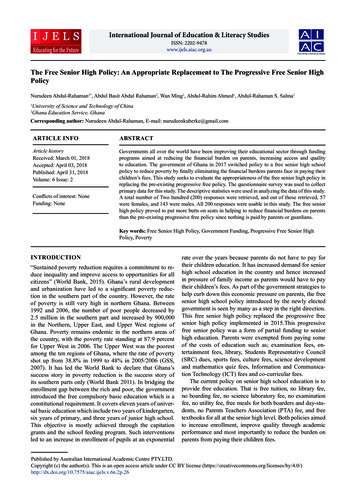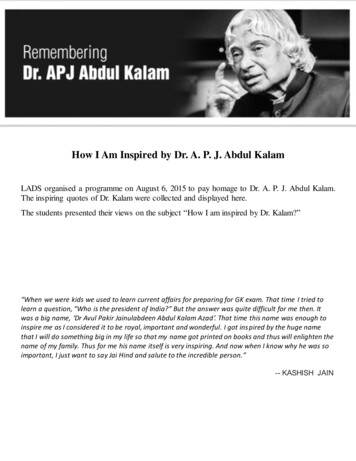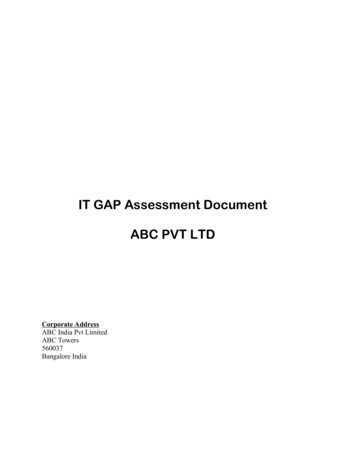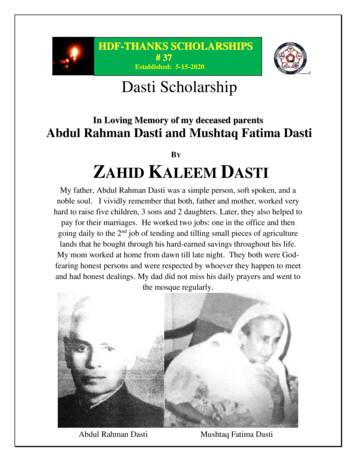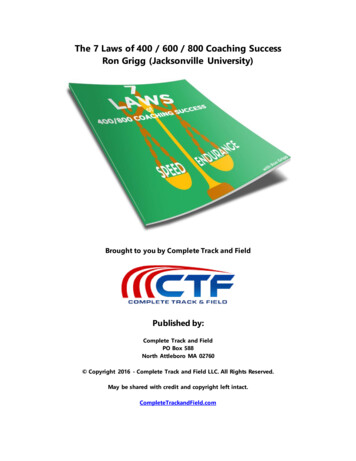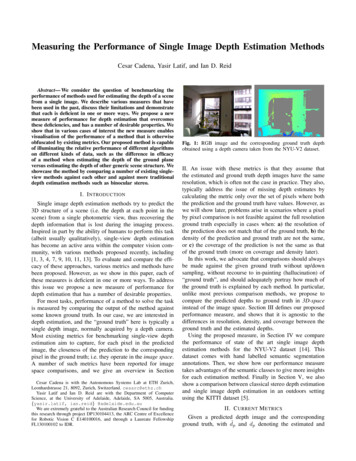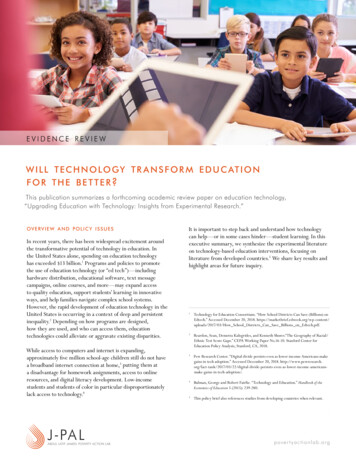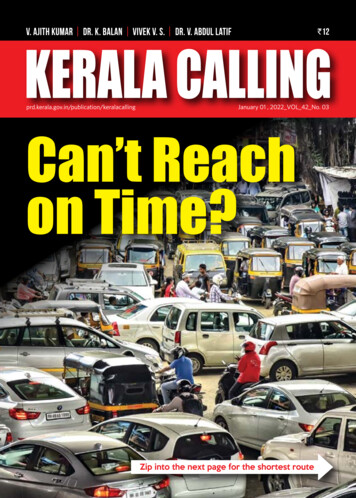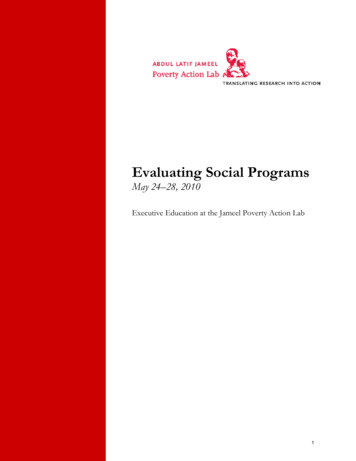
Transcription
Evaluating Social ProgramsMay 24–28, 2010Executive Education at the Jameel Poverty Action Lab1
2
Evaluating Social Programs Course Schedule 2009May 24, 2010 – May 28, 2010MIT, Room E51-395Monday, May 248:00 AM – 9:00 AMContinental Breakfast9:00 AM – 9:15 AMOpening Remarks9:15 AM – 10:30 AMLecture 1: What is Evaluation?Lecturer: Rachel Glennerster (MIT)10:30 AM – 12:00 PMCase 1 (Women as Policy Makers): Group Discussion and exercise12:00 PM – 1:30 PMLunch1:30 PM – 3:00 PMLecture 2: Outcomes, Indicators, and Measuring ImpactLecturer: Marc Shotland (MT )3:30 PM – 6:00 PMGroup Project Work (choose topics for presentation)Tuesday, May 258:00 AM – 8:30 AMContinental Breakfast8:30 AM – 10:00 AMCase 2 (Learn to Read Evaluations): Group Discussion and exercise10:30 AM – 12:00 PMLecture 3: Impact Evaluation – Why Randomize?Lecturer: Dan Levy (Harvard University)12:00 PM – 1:30 PMLunch1:30 PM – 3:00 PMLecture 4: How to Randomize?Lecturer: Leigh Linden (Columbia University)3:30 PM – 4:45 PMExercise 1: Mechanics of Randomization3:30 PM – 5:00 PMCase 3 (Extra Teacher Program): Group Discussion and exercise5:00 PM – 5:30 PMGroup Project5:45 PM- 8:30 PMDinner at “The Elephant Walk”http://www.elephantwalk.com/3
Wednesday, May 268:00 AM – 8:30 AMContinental Breakfast8:30 AM – 9:15 AMExercise 2: Random Sampling and Law of Large Numbers9:30 AM – 12:00 PMLecture 5: Sampling and Sample SizeLecturer: Ben Olken (MIT)12:00 PM – 1:30 PMLunch1:30 PM – 3:00 PMExercise 3: Power Calculations, Sample Size3:00 PM – 4:30 PMLecture 6: Implementing an EvaluationLecturer: Shawn Cole (Harvard University)5:00 PM – 6:00 PMGroup ProjectThursday, May 278:00 AM – 8:30 AMContinental Breakfast8:30 AM – 10:00 AMCase 4 (Deworming in Kenya): Group Discussion and Exercise10:30 AM – 12:00 PMLecture 7: Analysis and InferenceLecturer: Shawn Cole (Harvard University)12:00 PM – 1:30 PMLunch1:30 PM – 3:00 PMLecture 8: Randomized Evaluation: Start-to-FinishLecturer: Nava Ashraf (Harvard University)3:30 PM – 6:00 PMGroup Project: finalize presentationFriday, May 288:00 AM – 9:00 AMContinental Breakfast9:00 AM – 12:00 PMGroup Presentations12:00 PM – 1:00 PMLunch1:00 PM – 3:00 PMGroup Presentations3:00 PM – 4:00 PMCourse Wrap Up4
Lecturer BiosNava AshrafNava Ashraf is an Assistant Professor at Harvard Business School. Her research focuses on howpeople make decisions, applying principles from economics and psychology to design moreeffective development interventions. She has conducted randomized evaluations of savingsinnovations in the Philippines, an agricultural marketing intervention in Kenya, and is currentlyworking on a randomized evaluation of socially-marketed health products in Zambia. Shereceived her Ph.D in Economics from Harvard University in 2005 and her B.A. in Economicsand International Relations for Stanford University in 1998.Shawn ColeShawn Cole is an assistant professor in the Finance Unit at Harvard Business School, where hecurrently teaches the first half of the required finance course in the MBA program. His researchexamines corporate finance and banking in developing countries, covering topics such as bankcompetition, government regulation, and how financial development affects economic growth.Before joining the Harvard Business School, Professor Cole worked as an assistant economist atthe Federal Reserve Bank of New York. He served as chair of the endowment managementcommittee of the Telluride Association, a non-profit educational organization, for several years.He received a Ph.D. in Economics from the Massachusetts Institute of Technology in 2005,where he was an NSF and Javits Fellow, and an A.B. in Economics and German Literature fromCornell University.Rachel GlennersterRachel Glennerster joined the Abdul Latif Jameel Poverty Action Lab at MIT as ExecutiveDirector in 2004. She earned her B.A. in Philosophy, Politics, and Economics from OxfordUniversity and her Ph.D. in Economics from the University of London. She was an EconomicAdvisor at the UK Treasury and Development Associate at the Harvard Institute forInternational Development. She acted as Technical Assistant to the UK Executive Director of theIMF and World Bank focusing on loans to Russia and the former Soviet Union before joining theIMF staff in 1997. At the IMF she assisted countries affected by the Kosovo crisis, helpednegotiate a major debt relief package for Mozambique, and helped design and implementreforms to the International Financial System in the aftermath of the Asian Financial Crisis. Sheis coauthor of Strong Medicine: Creating Incentives for Pharmaceutical Research on NeglectedDiseases. Her current research includes evaluations of public health and educationinterventions in India, community-driven development in Sierra Leone, and ways to empoweradolescent girls in Bangladesh.5
Dan LevyDan Levy is Lecturer in Public Policy and Faculty Chair of the MPA Program at HarvardUniversity’s John F. Kennedy School of Government. He has served as a Senior Researcher atMathematica Policy Research, where he has been involved in the evaluation of several socialprograms. His teaching focuses on quantitative methods and program evaluation. His researchinterests lie in the general area of social policy. He currently serves as the Deputy ProjectDirector of the evaluation of the PATH program, a conditional cash transfer program inJamaica. He has been involved in the evaluation of an after-school program, a methodologicalreview of studies comparing the use of random assignment and quasi-experimental methods toestimate program impacts, and a technical assistance project with Mexico’s Social DevelopmentMinistry (Sedesol). He has also served as a Research Affiliate of the Joint Center for PovertyResearch, an Adjunct Faculty Member at Georgetown Public Policy Institute, and a consultant atthe World Bank. He received his Ph.D. in Economics from Northwestern University and his B.A.from Universidad Metropolitana (Caracas, Venezuela). He is fluent in Spanish and French.Leigh LindenLeigh Linden is an Assistant Professor in both the Department of Economics and the School ofInternational and Public Affairs at Columbia University. His research focuses on the ability ofsocial services to improve the well being of children, especially in impoverished areas. Hereceived his Ph.D. in Economics from the Massachusetts Institute of Technology in 2004 andhis a B.S. in Mathematics and a B.A. in Economics in 1997 from the University of Texas atAustin.Ben OlkenBenjamin Olken received his Ph.D. in Economics from Harvard in 2004, and is currently aProfessor at Massachusetts Institute of Technology. His work focuses on empirical politicaleconomy questions in developing countries, with a particular emphasis on corruption. Most ofhis field work takes place in Indonesia, where he has conducted randomized field experimentsand extensive data collection. He is an Affiliate of the Abdul Latif Jameel Poverty Action Lab,Faculty Research Fellow of the National Bureau of Economic Research, an Affiliate of theBureau for Research and Economic Analysis of Development (BREAD), and a Research Affiliateof the Center for Economic Policy Research.Marc ShotlandMarc is the Senior Research Manager and Director of Research at J-PAL. He holds anMPA/International Development degree from Harvard University's Kennedy School ofGovernment and a Bachelors degree in Economics from Williams College. He first joinedProfessors Duflo and Banerjee in the summer of 2002 to run randomized evaluations ofeducation interventions as a field research associate in India. In 2004 he joined the PovertyAction Lab's Cambridge office as a research manager. He left in 2006 to earn his Masters atHarvard before rejoining J-PAL in 2008 in his current position.6
rafColeGlennersterLevyLindenOlkenShotlandGroup st amilaKeithEsuMary rna SingaporePeruUSACape VerdePhilippinesHaitiSouth AfricaSouth AfricaSouth PALJ‐PALMITJ‐PALBoston Consulting Group (BCG)/New School for Social ResearchSMU's Hunt Institute for Engineering and HumanityLee Kuan Yew School of Public PolicyThe World BankWomen for Women InternationalMonitoring and Evaluation Unit/Ministry of FinanceUNICEFPeasant Mouvement of Papaye (Haïti)University of Cape TownDepartment of Trade and IndustryIndependentAffirmation of Rights of Persons With Disability (ARPWD)Meijigakuin UniversityProfessional Assistance for Development Action ((PRADAN))Wellspring Advisors, LLCStephanie and Hunter Hunt Institute for Engineering & HumanityOrganizationWomen for Women InternationalCurrently unemployedMexican Ministry of Social DevelopmentInternational Food Policy Research Institute (IFPRI)TechnoServeThe BARKA FoundationJ‐PALMSF/HarvardWorld BankMillennium Challenge Corporation (MCC)Women for Women InternationalNortheastern UniversityDepartment of Trade and IndustryGeorge Washington University / GWIPPAssistant ProfessorHarvard / J‐PAL MemberAssistant ProfessorHarvard / J‐PAL MemberExecutive DirectorJ‐PALLecturer of Public PolicyHarvard / J‐PAL MemberAssistant ProfessorColumbia / J‐PAL MemberAssociate ProfessorMIT / J‐PAL MemberSenior Research Manager and Director of Research J‐PALPh.D CandidateResearch AnalystPolicy ResearcherResearch AnalystResearch AnalystPh.D CandidateResearch AnalystAssociate ProfessorProject ExecutiveProgram Associate (Researcher)Business Services Assistant/StudentSenior Project Monitoring and Evaluation OfficerTitleMonitoring and Evaluation SpecialistResearcherSub‐directorResearch AssistantStrategic Planning ManagerCo‐FounderPolicy AssociateHead of Mission/ Visiting FellowConsultantResident Country DirectorMonitoring & Evaluation OfficerLecturer / Research AssociateEconomistPhD student / Graduate Research AssistantExecutive DirectorBoard Co‐chairResearch FellowSenior Projects OfficerMonitoring & Evaluation OfficerHead of Monitoring and EvaluationMonitoring and Evluation SpecialistAgro‐economist/Project CoordinatorPost Doctorate FellowEconomistIndependent researcher and evaluator2010 Executive Education at the Jameel Poverty Action Labnashraf@hbs.eduscole@hbs.edurglenner@mit.edudan yan herine@bcg.com
8
Group OneRoom 216TA: Richard McDowellLuis AlberroVerna Jean HorganSub-DirectorMexican Ministry of Social Developmentlalberro@gmail.comExecutive DirectorHunt Institute for Engineering at SMUvjhorgan@lyle.smu.eduStephanie HuntKatherine TaitCo-Chair & Co-FounderHunt Institute for Engineering at SMUsteph-hunt@sbcglobal.netBusiness Services AssitantBoston Consulting Grouptait.katherine@bcg.com9
Group TwoRoom 218TA: Asha StenquistEsu AnahataMarco BoggeroCo-FounderThe BARKA Foundationinaandesu@barkafoundation.orgHead of Mission/Visiting FellowMSF Harvardmboggero@fas.harvard.eduInes KudoOluwasola OlanipekunSenior Projects OfficerThe World Bankikudo@worldbank.orgSenior Project Monitoring & Evaluation OfficerAffirmation of Rights of Persons With Disability(ARPWD)olanipekunsola@yahoo.com10
Group ThreeRoom 220TA: Emily BrezaAlawy AbdillahiKeith AmonlirdvimanMonitoring and Evaluation SpecialistWomen for Women Internationalaalawy@womenforwomen.orgStrategic Planning ManagerTechnoServekeith@tns.orgCamila AlvaCeline CarbullidoResearch AssistantInternational Food Policy Research Institutecamilachay@gmail.comMonitoring & Evaluation OfficerWomen for Women Internationalccarbullido@womeforwomen.orgAshley LeblancMonitoring & Evaluation OfficerWomen for Women Internationalaleblanc@womenforwomen.org11
Group FourRoom 222TA: Eric DodgeJonathan BrooksFlorencia GabrieleResident Country DirectorMillennium Challenge Corporationbrooksja@mcc.govLecturer / Research AssociateNortheastern Universitygabriele.f@husky.neu.eduMirian LimaDavid MilletHead of Monitoring and EvaluationMinistry of Finance, Cape t CoordinatorPeasant Mouvement of Papayemilletdavid@hotmail.comEleuthera SaProgram AssociateWellspring Advisorsesa@wellspringadvisors.com12
Group FiveRoom 234TA: Simone SchanerMary Ann BatesRadhika JoshiPolicy AssociateJameel Poverty Action Labmary.ann.53@gmail.comResearch FellowLee Kuan Yew School of Public Policyradhika.joshi@nus.edu.sgHammad MasoodMakiko OmuraMonitoring and Evaluation SpecialistUNICEFhmasood@unicef.orgAssociate ProfessorMeijigakuin Universitymakiko@eco.meijigakuin.ac.jp13
Group SixRoom 236TA: Reshma HussamMaria AguirreBertha sultantWorld Bankbbriceno@worldbank.orgDiana HincapieDilip RabhaPhD Student/ResearcherGeorge Washington Universitydianah@gwmail.gwu.eduProject ExcutiveProfessional Assistance for Development Actionudayan 3046@yahoo.co.in14
Group SevenRoom 238TA: Kamilla GumedeVarsha HarinathNeeta MisraEconomistDepartment of Trade & Industry, South AfricaVHarinath@thedti.gov.zaPost Doctorate FellowUniversity of Cape Townneeta.misra@uct.ac.zaMoleboheng NteneErin O’BrienEconomistDepartment of Trade & Industry, South Africamntene@thedti.gov.zaResearcher & EvaluatorIndependenterin.louise@gmail.com15
Group Work InstructionsGroups are assigned to the follow locationsE51-216, Group 1E51-218, Group 2E51-220, Group 3E51-222, Group 4E51-234, Group 5E51-236, Group 6E51-238, Group 7You will be assigned to groups of 5-6 people. We will do our best to ensure that each group includes participantswith a range of different experiences but some common areas of interest. You will carry out two types of activitieswithin these groups:i)Casework and discussionsii)Preparation of group proposalCasework and DiscussionsEach case covers a specific set of topics which are the subject for the lectures for each day of the course. The casesprovide background on one (or in some cases two) specific evaluations which will be referred to in the lectures. Inaddition, each case includes discussion topics designed to get you thinking about the issues prior to the lectures.Some of the cases also include exercises for you to complete. You will be provided with Excel files containing theseexercises at the start of the “group work” sessions. You will be expected to read the relevant case, go through thediscussion topics, and complete the exercises before the related lecture on the case.It is very important that you come to the case discussion having read the case as there is no time to read the caseand work through the questions in the time allocated.Group ProposalEach group will—over the course of the week—work on a proposal for an evaluation on a topic of their choice.Different aspects of evaluation will be covered in the lectures and the casework, and these should be reflected inthe group proposal. On Saturday, each group will present their proposal and receive comments from the otherparticipants and the lecturers. This is an ideal time to get feedback on an evaluation you may be planning.The output for the project will be a 20-minute presentation (with an additional 10 minutes for questions andfeedback).16
The presentation should cover the following issues:i)The objective and rationale of the evaluation—what is the question you are asking and why is itimportant or interesting?ii)Measurement issues—how will you measure whether the program is a success? On what variables willdata be collected? How will it be collected? In addition to final outcome measures, will you becollecting data on the mechanism by which the program works? If so, what data will you collect onthis?iii)Randomization design—how will the treatment and control groups be determined, and at what levelwill the randomization take place?iv)What magnitude of effect will you be trying to detect? What is the sample size you will be using? Whyis this the correct sample size?v)What are the risks to the integrity of the evaluation? How will you seek to minimize these?vi)How will the data be analyzed?vii)To what use will you put the results? How will the results impact future policy/programs?17
The presentation should cover the following issues:The objective and rationale of the evaluation—what is the question you are asking and why is it important orinteresting?viii)Randomization design—how will the treatment and control groups be determined, and at what level will therandomization take place?ix)Measurement issues—how will you measure whether the program is a success? On what variables will data becollected? How will it be collected? In addition to final outcome measures, will you be collecting data on themechanism by which the program works? If so, what data will you collect on this?What magnitude of effect will you be trying to detect? What is the sample size you will be using? Why is this thecorrect sample size?x)What are the risks to the integrity of the evaluation? How will you seek to minimize these?xi)How will the data be analyzed?xii)To what use will you put the results? How will the results impact future policy/programs?18
Case 1:3: Women as PolicymakersMeasuring the effects of political reservationsThinking about measurement and outcomesThis case study is based on “Women as Policy Makers: Evidence from aChattopadhyay and Esther Duflo (2004a), Econometrica 72(5), 14091443.J-PAL thanks the authors for allowing us to use their paper19
Case 1: Women as PolicymakersIndia amended its federal constitution in 1992, devolving powerto plan and implement development programs from the states torural councils, or Gram Panchayats (Village Councils). TheVillage Councils now choose what development programs toundertake and how much of the budget to invest in them. Thestates are also required to reserve a third of Village Council seatsand Village Council chairperson positions for women. In moststates, the schedule on which reserved seats and positions cycleamong the Village Councils is determined randomly. This createsthe opportunity to rigorously assess the impact of quotas onpolitics and government: Do the policies differ when there aremore women in government? Do the policies chosen by womenin power reflect the policy priorities of women? Sincerandomization was part of the Indian government program itself,the evaluation planning centered on collecting the data needed tomeasure impact. The researchers’ questions were what data tocollect, what data collection instruments to use, and what samplesize to plan for.Empowering the Panchayati RajVillage Councils, known locally as Panchayats, have a long tradition in rural India. Anassembly (yat) of five (panch) elders, chosen by the community, convened to mediatedisputes between people or villages. In modern times Village Councils have beenformalized into institutions of local self-government.The impetus to formalize came from the independence leaders, who championeddecentralized government. Gandhi favored village self-government, a system whereevery village would be “self-sustained and capable of managing its affairs.” Primeminister Nehru advocated giving the Village Councils “great power,” so that ruralIndians would “have a greater measure of real swaraj (self-government) in their ownvillages.”Thus Article 40 of the constitution—adopted at independence—directs the states toensure that the Village Councils “function as units of self-government.”Implementation guidelines recommended a three-tier system, with Village Councilsas the grassroot unit.1 Most states followed both the directive and the guidelines sothat by the early 1950s they had formalized Village Councils. But in the 1960s, withno real power and no political and financial support from the federal government, theVillage Councils disappeared in most states. It was not until the 1990s that they wererevived.The revival came through the constitution. In 1992, India enacted the 73rdamendment, which directed the states to establish the three-tier Panchayati Rajsystem and to hold Village Council elections every five years. Councilors are popularlyelected to represent each ward. The councilors elect from among themselves a councilchairperson called a pradhan. Decisions are made by a majority vote and thechairperson has no veto power. But as the only councilor with a full-timeappointment, the chairperson wields effective power.1 Village councils, called Gram Panchayats, form the basic units of the Panchayat Raj. Village councilchairs, elected by the members of the village council, serve as members of the block—subdistrict—council(panchayat samiti). At the top of the system is the district council (zilla parishad) made up of the blockcouncil chairs.1The Abdul Latif Jameel Poverty Action Lab@MIT, Cambridge, MA 02130, USA @IFMR, Chennai 600 008, India @PSE, Paris 75014, France20
Thinking about measurement and outcomesThe 73rd amendment aimed to decentralize the delivery of public goods and servicesessential for development in rural areas. The states were directed to delegate thepower to plan and implement local development programs to the Village Councils.Funds still come from the central government but are no longer earmarked forspecific uses. Instead, the Village Council decides which programs to implement andhow much to invest in them. Village Councils can chose programs from 29 specifiedareas, including welfare services (for example, public assistance for widows, care forthe elderly, maternity care, antenatal care, and child health) and public works (forexample, drinking water, roads, housing, community buildings, electricity, irrigation,and education).Empowering women in the Panchayati RajThe Village Councils are large and diverse. In West Bengal, for example, each has upto 12 villages and up to 10,000 people, who can vary by religion, ethnicity, caste, and,of course, gender. Political voice varies by group identities drawn along these lines. Ifpolicy preferences vary by group identity and if the policymakers’ identities influencepolicy choices, then groups underrepresented in politics and government could beshut out as Village Councils could ignore those groups’ policy priorities. There werefears that the newly empowered Village Councils would undermine the developmentpriorities of traditionally marginalized groups, such as women. To remedy this, the73rd amendment included two mandates to ensure that investments reflected theneeds of everyone in the Village Council.The first mandate secures community input. If Village Council investments are toreflect a community’s priorities, the councilors must first know what those prioritiesare. Accordingly, Village Councils are required to hold a general assembly every sixmonths or every year to report on activities in the preceding period and to submit theproposed budget to the community for ratification. In addition, the Chairpersons arerequired to set up regular office hours to allow constituents to formally requestservices and lodge complaints. Both requirements allow constituents to articulatetheir policy preferences.The second mandate secures representation in the council for women. States arerequired to reserve at least a third of all council seats and Chairperson positions forwomen. Furthermore, the states have to ensure that the seats reserved for women are“allotted by rotation to different constituencies in a Panchayat [Village Council]” andthat the chairperson positions reserved for women are “allotted by rotation todifferent Panchayats [Village Councils].” In other words, they have to ensure thatreserved seats and chairperson positions rotate evenly within and among the VillageCouncils.Randomized quotas in India: What can it teach us?Your evaluation team has been entrusted with the responsibility to estimate theimpact of quotas for women in the Village Councils. Your evaluation should addressall dimensions in which quotas for women are changing local communities in India.What data will you collect? What instruments will you use? How large will yoursample be?As a first step you want to understand all you can about the quota policy. What needsdid it address? What are the pros and cons of the policy? What can we learn from it?2The Abdul Latif Jameel Poverty Action Lab@MIT, Cambridge, MA 02130, USA @IFMR, Chennai 600 008, India @PSE, Paris 75014, France21
Case 1: Women as PolicymakersDiscussion Topic 1: Gender quotas in the Village Councils1.What were the main goals of the Village Councils?2.Women are underrepresented in politics and government. Only 10 percent of India’snational assembly members are women, compared to 17 percent worldwide.Does it matter that women are underrepresented? Why and why not?3.What were the framers of the 73rd amendment trying to achieve when theyintroduced quotas for women?Gender quotas have usually been followed by dramatic increases in the politicalrepresentation of women. Rwanda, for example, jumped from 24th place in the “women inparliament” rankings to first place (49 percent) after the introduction of quotas in 1996.Similar changes have been seen in Argentina, Burundi, Costa Rica, Iraq, Mozambique, andSouth Africa. Indeed, 17 of the top 20 countries in the rankings have quotas.Imagine that your group is the national parliament of a country deciding whether to adoptquotas for women in the national parliament. Randomly divide your group into two parties,one against and one for quotas.4.Debate the pros and cons of quotas. At the end of the debate, you should have a listof the pros and cons of quotas.5.What evidence would you collect to strengthen the case of each party?What data to collectFirst, you need to be very clear about the likely impact of the program. It is on thosedimensions that you believe will be affected that you will try to collect data. What arethe main areas in which the quota policy should be evaluated? In which areas do youexpect to see a difference as a result of quotas?What are all the possible effects of quotas?Discussion Topic 2: Using a logical framework to delineate yourintermediate and final outcomes of interest1.Brainstorm the possible effects of quotas: positive, negative, and no effects.Hint: Use your answers to Discussion Topic 1 as a starting point.2.For each potential effect on your list, list also the indicator(s) you would use for thateffect. For example, if you say that quotas will affect political participation of women,the indicator could be “number of women attending the General Assembly.”Multiple outcomes are difficult to interpret, so define a hypothesisQuotas for women could produce a large number of outcomes in different directions.For example, it may improve the supply of drinking water and worsen the supply ofirrigation. Without an ex-ante hypothesis on the direction in which these differentvariables should be affected by the quota policy, it will be very difficult to make senseof any result we find. Think of the following: if you take 500 villages and randomlyassign them in your computer to a “treatment” group and a “control” group, and thenrun regressions to see whether the villages look different along 100 outcomes, wouldyou expect to see some differences among them? Would it make sense to rationalizethose results ex-post?3The Abdul Latif Jameel Poverty Action Lab@MIT, Cambridge, MA 02130, USA @IFMR, Chennai 600 008, India @PSE, Paris 75014, France22
Thinking about measurement and outcomesThe same applies to this case: if you just present your report in front of thecommission who mandated you to evaluate this policy, explaining that the quota forwomen changed some variables and did not change others, what are they supposed tomake of it? How will they know that these differences are not due to pure chancerather than the policy? You need to present them with a clear hypothesis of howquotas are supposed to change policymaking, which will lead you to make predictionsabout which outcomes are affected.Discussion Topic 2 continued :3.4.5.Suppose you had all the money and resources in the world and could collect data onevery one of these indicators in communities with and without quotas, and comparethem. How many indicators would you collect?What might be some examples of key hypotheses you would test? Pick one.Which indicators or combinations of indicators would you use to test your keyhypothesis?Use a logical framework to delineate intermediate and final outcomesA good way of figuring out the important outcomes is to lay out your theory ofchange; that is, to draw a logical framework linking the intervention, step by step, tothe key final outcomes.Discussion Topic 2 continued :6.What is the possible chain of outcomes in the case of quotas
received her Ph.D in Economics from Harvard University in 2005 and her B.A. in Economics and International Relations for Stanford University in 1998. Shawn Cole Shawn Cole is an assistant professor in the Finance Unit at Harvard Business School, where he currently teaches the first half of the required finance course in the MBA program. His .
